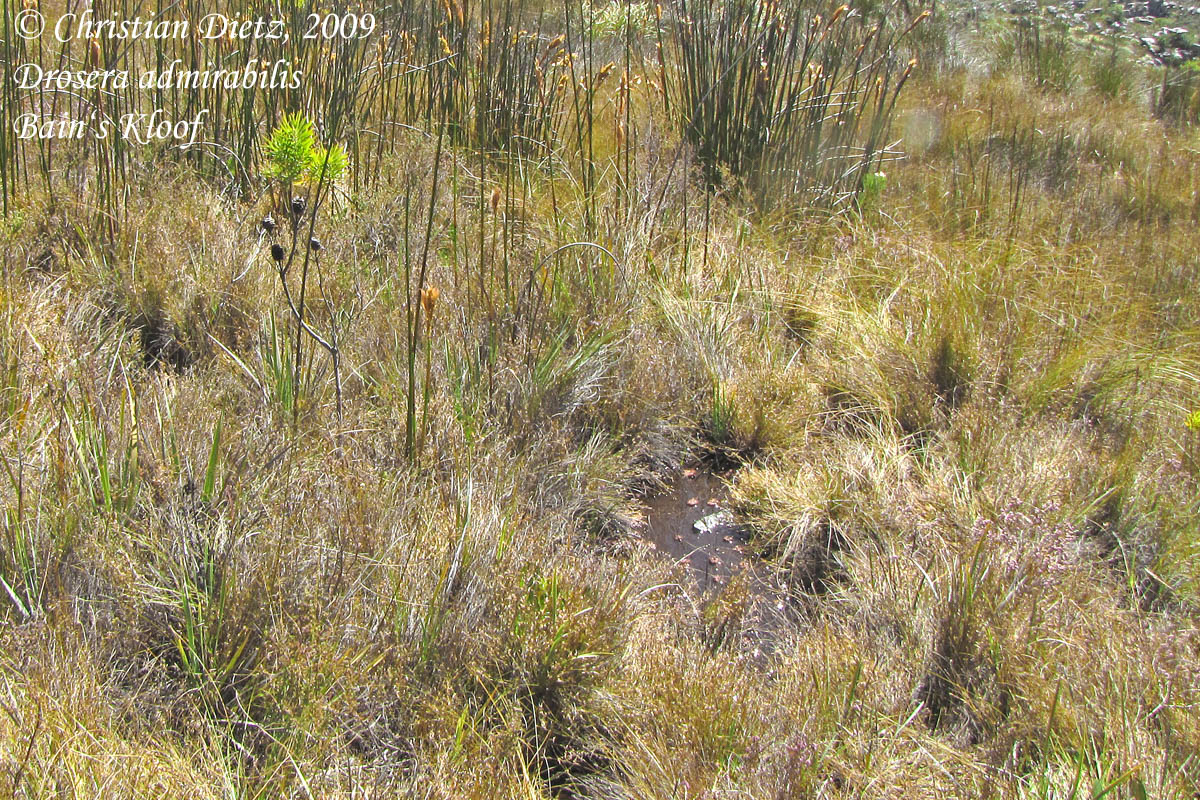|
|
Post by John Brittnacher on Jan 5, 2011 6:03:37 GMT
Are there any other carnivores growing in association with Drosera regia or even near where it grows? I suspect not from looking at the photos. It doesn't look like typical CP habitat to me in terms of what else can grow there and how well it grows.
|
|
|
|
Post by marcel on Jan 5, 2011 17:56:32 GMT
There is a Drosera capensis population at the lower altitudes of this pass the (in)famous "Baines kloof" form.
By the way:
This is how it is listed/sold but the proper name should be "Bains Kloof".
Said Kloof (meaning ravine or crevice) was named after Andrew Geddes Bain, a Cape inspector of roads who build the road here in 1853.
|
|
|
|
Post by Christian on Jan 8, 2011 14:28:07 GMT
Hi,
there is Drosera admirabilis growing directly with Drosera regia. We could not find any other Drosera growing at this location. On the way to the location we also found Drosera trinervia.
Yes, there is D. capensis growing somewhere in the Bain's Kloof Valley, but not anything close to D. regia.
Christian
|
|
|
|
Post by John Brittnacher on Jan 8, 2011 18:13:35 GMT
The reason I asked about details is I just wrote a page for the ICPS Seed Bank site on growing D. regia. www.carnivorousplants.org/seedbank/species/D_regia.htmI find knowing about where a plant grows in the wild is helpful in growing the plants myself. It is interesting D. admirabilis grows there as well. Does it grow immediately with D. regia or are there separate bare areas? If anyone has comments about growing D. regia from seed or the new web page, please e-mail me at the address on the bottom of the Seed Bank web page. It seems some people have trouble growing D. regia from seed while others don't. I don't know specifically what to advise. I have never bothered to grow them from seed because a few root cuttings produce more plants than I have room for. |
|
|
|
Post by Christian on Jan 8, 2011 21:58:45 GMT
Hi John, the D. admirabilis (the form we know as sp. "floating" in cultivation) are growing more or less directly with the D. regia. While D. regia grows in the thick vegetation, the D. admirabilis have only been growing in a small puddle. I think, this is due to the fact, that this is the only place where some sunlight can reach the bottom. I could well imagine, that it would also grow throughout the whole D. regia habitat if it was open enough. I have attached a general overview of this location to show what i mean. There are also D. regia in this picture, but you won't see them as they have the same color as the other plants   Christian |
|
|
|
Post by John Brittnacher on Jan 10, 2011 3:21:02 GMT
That looks just like Darlingtonia and Drosera rotundifolia in mountainous seeps. Darlingtonia would be in the matted vegetation and D. rotundifolia in the water.
|
|
|
|
Post by tanukimo on Mar 11, 2014 21:25:20 GMT
Thank you so much for fixing the links!
It looks pretty hot where the plants are but I guess it isn't because of the elevation.
The plants look ethereal with the tentacles blending with the background. The pictures really gave me a sense of how difficult it must be for the plants growing in such as place. It's surprising to see the "giant" of Drosera being towered over by grass. It is a really unique habitat.
|
|
|
|
Post by Christian on Mar 11, 2014 21:58:01 GMT
Hi,
it's not really a warm place, at least not in September. It can be cold, wet, windy and foggy there. I have been there twice meanwhile. In 2009 we had luck with the weather, which was quite the opposite in 2012 (one of the days i will remember a long time as we were literally swimming while going there).
It is said, that there could also be some snow in the winter months in the higher regions of that Mountains.
Christian
|
|
|
|
Post by partisangardener on Jan 9, 2016 17:40:03 GMT
Are there any news about the populations in the wild after the fire?
Now should be every population plain to see.
|
|
|
|
Post by partisangardener on Oct 30, 2016 9:48:46 GMT
Still no news?
|
|
|
|
Post by peterhewitt on Nov 4, 2016 20:28:22 GMT
Just as an answer to this question. After the recent fires in Baines kloof the Stellenbosch Botanical Gardens sent a team up to check on the one known population that was left. the good news is that the Drosera regia population/s in Baines kloof are far more extensive than previously thought. 12 new sites were found in the lower altitude region of the mountain and the Population above the waterfall was redsicovered in good condition. Seeds were legally collected from Both altitudes and new sites. Seeds of the higher altitude form will be sent by me to BCP this winter for propagation and distibution when they are established.
|
|
|
|
Post by partisangardener on Nov 5, 2016 10:36:40 GMT
Thanks a lot for this update. This is what I hoped for. Now it is reality.
I expect now some spectacular pictures from not so much overgrown D.regia.
|
|







